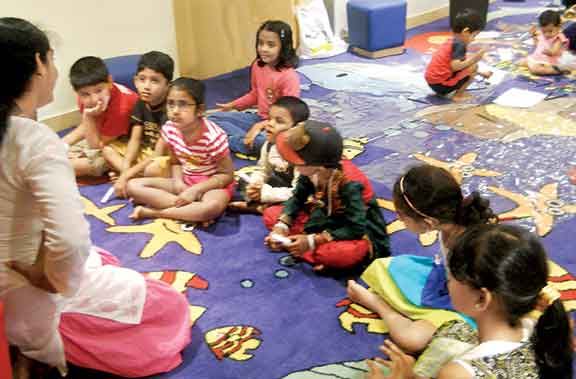Bhuvanesware BG
As we were growing up, I am sure we were fed with some amount of stories by the adults around us. In the present day scenario, children are taught/trained to tell stories for their grades and competitions. It’s time for us to look at storytelling as more than just another weekend activity. As our education system invites innovative and novel ideas in the teaching-learning process I take courage in discussing the benefits of the “art of storytelling” in the classroom.
Storytelling is similar to clay; we can adapt and shape it as per our requirements. Storytelling can help:
- Develop discipline, healthy student attitude and promote moral values
- Develop interpersonal and life skills
- Support and facilitate the teaching-learning process
Storytelling is a narrative process that involves sequential events framed in an orderly fashion that encourages imagination, visualization, and participation. It is an interactive and engaging two-way process where both the storyteller and the audience are deeply involved. This permits travel from self-awareness to awareness of others. Characters in the story serve as role-models in setting principles. Learning from the characters’ experiences extends the emotional development in children and they are provided with an opportunity to learn critical life skills such as decision-making, empathy, assertiveness, etc. Stories can also serve as strong tools in introducing expected classroom behaviour, disciplinary strategies, and discussing the consequences and corrective measures of ill attitudes.
Storytelling and learning: Storytelling helps reach all kinds of learners – visual, auditory, and kinaesthetic – as it involves body movement/gesture, voice, and visual expressions. These senses are intact and in connection with each other, and allow audio-visual-motor coordination at the same time. The whole process involves continual listening which in turn helps improve and sustain attention span.
Storytelling activities provide wide avenues to build strong teacher-student relationship as they work as a team. The basic structure of any story involves sequencing which helps children develop the skill of recall. Children with difficulty in writing and comprehending are found to benefit with storytelling as it helps them visualize and create their own imaginary representation permitting better understanding. This simplifies the process when it comes to their sharing the same in a written format at a later stage. They also cultivate confidence in reasoning and fearless expression of ideas. Learning thus turns out to be fun and revising just another rehearsal.
Activities like sentence formation, quiz, vocabulary building, puzzles solving, drawing, role-playing, drama, dance, etc., can be combined with storytelling as per the requirements and subject needs in order to reinforce the learning and to make it even more interesting. Introduce an imaginary character or a familiar one and develop stories around that character. This will enable a continual and interesting process of learning, as familiarity will gain easy registration of the content learned. It is also recommended that teachers follow the story with discussions using open-ended questions so as to analyze the learning outcomes (be it academics or other objectives). Teachers will get a better sense of students’ levels of comprehension. It is essential that teachers be open to and in fact, encourage answers that have deviated from the core objectives. This helps children build on their imagination while drawing connections to the topic under discussion.
Teacher as a storyteller: Teaching itself requires wide skills related to storytelling. With careful selection of stories and a little practice, the effectiveness of storytelling can be achieved. Delivery of stories can be designed taking into consideration the age groups of the audience. Besides this, a storyteller needs a sense of open-mindedness, a fun-loving nature and a willingness to innovate. Want your students to look forward to your class and enjoy learning? Storytelling is the best way to make that happen!
Story selection: Epics, traditional stories, and self and child created stories are major story forms scattered all over the world. While choosing a story it is important to keep the group requirements and the desired goal in mind. As there is no hard and fast rule, feel free to make modifications to suit your requirements and don’t be afraid to create some stories of your own. Stories and storytelling need not be limited to kindergarten and primary schooling – this art can be extended to high school and senior secondary classes by just keeping the entertaining element of storytelling a little flexible and adaptive.
Student as a storyteller: Once the art of storytelling is initially introduced in class, interested students can be invited to take up the role of the teller and take turns to do so. When students are directly involved, the effect is deeper and the learning becomes wider. Students’ ability to construct and interpret ideas improves with multiple sessions. With the students taking the responsibility of learning and the sharing of that learning into their own hands, the teacher can serve as a facilitator or mentor and encourage the students while supervising their work.
*Maintaining a record of storytelling activities will help evaluate its effectiveness, understand the best practices and make available the references in the future.
______________________________________________________________________________
References
http://www.unesco.org/education/tlsf/mods/theme_d/mod21.html
http://www.storynet-advocacy.org/edu/
http://www.storytellinginstitute.org/3.htmlc
The author is a Chennai-based psychologist, storytelling trainer and arts-based therapy practitioner with experience in school counselling. Know more about her work on www.letstalkchennai.org. She can be reached at contact@letstalkchennai.org.


